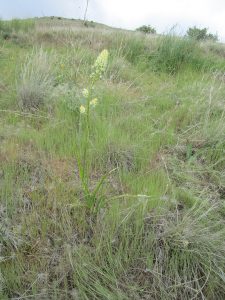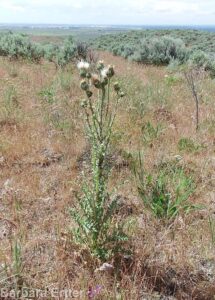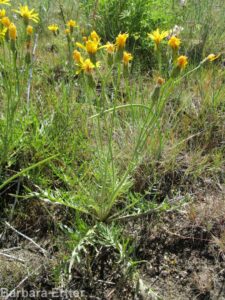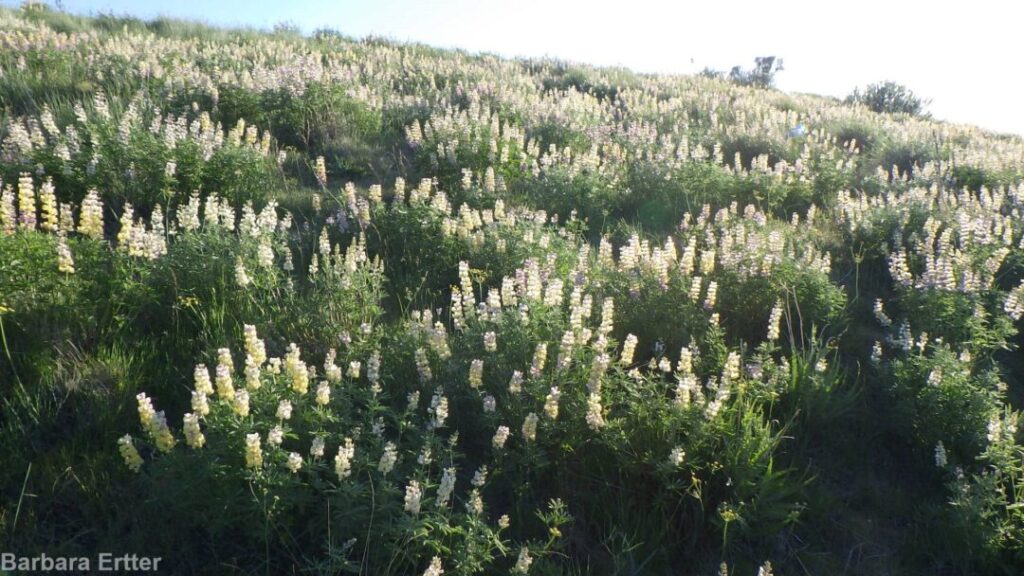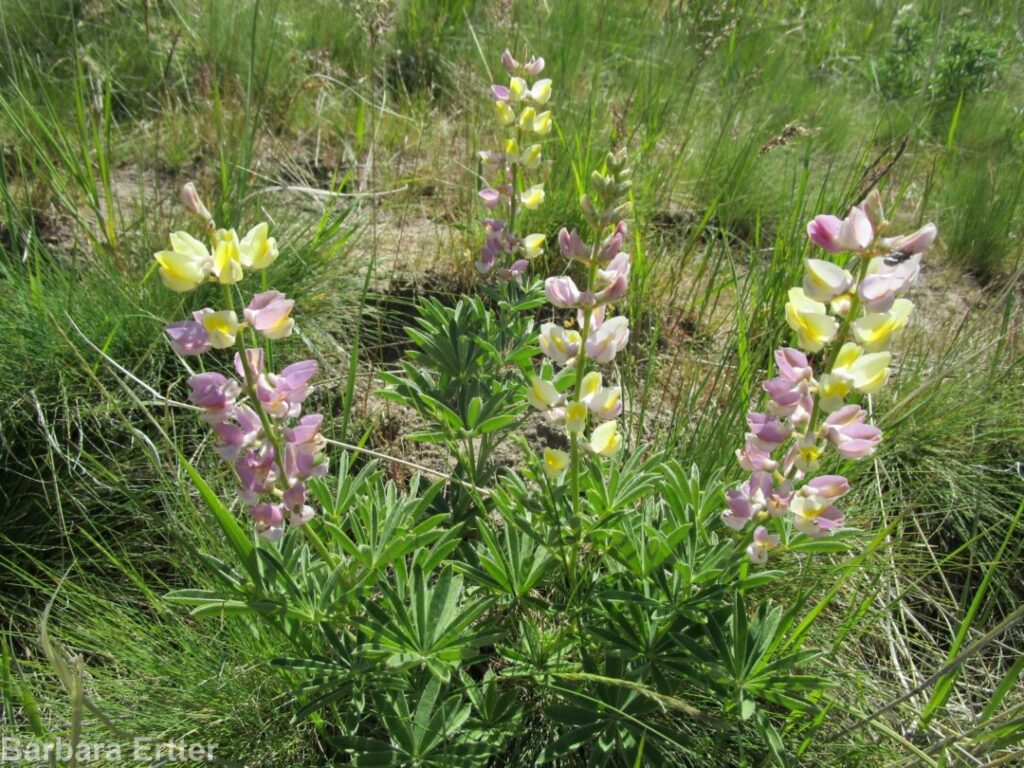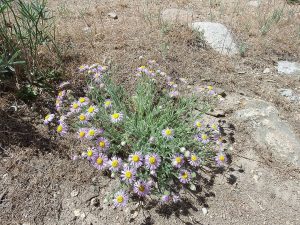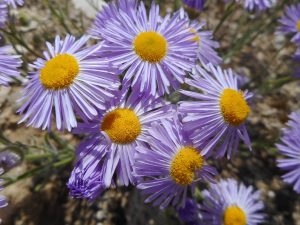MILLER GULCH WILDFLOWER WALK
early to mid May
Description: This short walk is primarily to enjoy a magnificent population of spurred or ‘polychrome’ lupine at peak bloom (and fragrance!), along with a nice selection of other locally unusual plants on good-quality habitat. The walk to the lupines is only 1 mile round-trip, with 300 feet elevation gain; several options exist for anyone wanting to go farther on Corrals Trail.
From the Miller Gulch trailhead (just past milepost 3 on Bogus Basin Road), follow the trail across a grassy west-facing slope, where you might spot foothills death-camas (Toxicoscordion aniculatum, previously in Zigadenus), our native gray-green thistle (Cirsium cymosum var. canovirens), and western hawksbeard (Crepis occidentalis).
As the trail curves around to the north side of hill, you will start seeing lupines, but keep going! Take time to appreciate the good-quality shrub-steppe habitat, with abundant perennial wildflowers, bunchgrasses, and scattered shrubs separated by open areas that are largely free of invasive annual grasses. These open areas are a critical component of this habitat type, providing critical ecosystem functions and also reducing the spread of wildfires. Among the plants you might notice are Modoc hawksbeard (Crepis modocensis), which blooms earlier and has much more divided leaves than the western hawksbeard.
Your patience eventually pays off when you reach the main lupine patch at the crest of the ridge. With luck, you will have arrived at peak bloom, when the air is scented with the fragrance given off by the lupine flowers. Although longspur lupine is the “official” common name, I like to call the populations in the Boise foothills the “polychrome lupine”, because the flowers are so wildly varied in color, even more so locally than is the norm for this species. Some of the color difference, especially on the same plant, is how the plant communicates with its pollinators (most bees); the flowers change color when they are ready for pollinating, and then change again to a different color when the have already been pollinated, or are at least past peak.
The plant list for this walk continues to the junction with Corrals Trail, not far beyond the main lupine patch. Doing so adds some “plateau” habitat and a few additional species, depending on the season. Possibilities include native woolly plantain (Plantago patagonica), shaggy fleabane (Erigeron pumilus var. intermedius), and Douglas’ sedge. From the junction, you have the option of turning left and continuing your walk as far as you want on Corrals Trail, retracing your route, or turning right to make a loop with Corrals trailhead and a walk along the side of the road back to Millers Gulch trailhead.
PLANT LIST [updating needed]
NOTE: Please enjoy the wildflowers and leave them for others to enjoy. Because our unique local flora is already under pressure from invasive weeds and habitat loss, harvesting of native plants is not encouraged on this website, especially along popular trails.
Flowering plants are listed in likely order of occurrence from trailhead; some might not yet be in bloom, or present during a particular year. * indicates native species
WILDFLOWERS
- *Fiddleneck (Amsinckia spp.) species difficult to distinguish
- *Stork- or cranesbill, filaree (Erodium cicutarium) non-native
- *Woolly-pod milkvetch (Astragalus purshii var. glareosus)
- *Yarrow (Achillea millefolium)
- *Foothill death-camas (Toxicoscordion/Zigadenus paniculatum)
- *Western hawksbeard (Crepis occidentalis)
- *Intermediate hawksbeard (Crepis intermedia) and/or *Tapertip hawksbeard (Crepis acuminata)
- *Wild-hyacinth, large-flowered triteleia, or Douglas’s brodiaea (Triteleia grandiflora, previously Brodiaea douglasii)
- *Narrowleaf biscuitroot (Lomatium simplex, previously included in L. triternatum, nine-leaf biscuitroot)
- *Arrowleaf balsamroot (Balsamorhiza sagittata)
- *Gray-green thistle (Cirsium cymosum var. canovirens) the only locally native thistle
- *Longspur or polychrome lupine (Lupinus arbustus [= L. laxiflorus in older references])
- *Small or garden burnet (Sanguisorba minor, alternatively Poterium sanguisorba) non-native, frequently included in post-fire seeding mixes for livestock and wildlife forage
- *Alfalfa (Medicago sativa) non-native
- *Pricklyleaf phlox (Phlox aculeata) intergrading with more elongate Longleaf phlox (Phlox longifolia)
- *Western hawksbeard (Crepis occidentalis)
- *Woolly plantain, Indian-wheat (Plantago patagonica)
- *Shaggy fleabane (Erigeron pumilus var. intermedius)
- *Dwarf or low pussytoes (Antennaria dimorpha)
SHRUBS AND TREES (mostly not in bloom)
- *Bitterbrush, Antelope brush (Purshia tridentata)
- *Rubber rabbitbrush (Ericameria [formerly Chrysothamnus] nauseosa)
- *Basin big sagebrush (Artemisia tridentata ssp. tridentata)
PRIMARY BUNCHGRASSES & GRASSLIKE PLANTS (mostly not in bloom, but evident)
- *Bulbous bluegrass (Poa bulbosa)
- *Threeawn grass (Aristida purpurea var. longiseta)
- *Sheep fescue (Festuca ovina) or possibly Idaho fescue (F. idahoensis) local populations probably all intentionally introduced
- *Needle-and-thread grass (Hesperostipa comata [previously Stipa])
- *Intermediate wheatgrass (Thinopyrum intermedium, alternatively in Elytrigia or Elymus)
- *Squirreltail grass (Elymus elymoides, formerly Sitanion hystrix)
- *Crested wheatgrass (Agropyron cristatum) intentionally introduced non-native
- *Bluebunch wheatgrass (Pseudoroegneria spicata, alternatively in Agropyron or Elymus) both native-to-site and planted races from other sites probably present
- *Sandberg bluegrass (Poa secunda)
- *Douglas’ sedge (Carex douglasii)
SIGNIFICANT NOXIOUS WEEDS (some not yet in bloom, but evident)
- *Cereal or feral rye (Secale cereale)
- *Mouse or wall barley (Hordeum murinum)
- *Rush skeletonweed (Chondrilla juncea)
- *Medusahead grass (Taeniatherum/Elymus caput-medusae)
- *Tumble or Jim Hill mustard (Sisymbrium altissimum)
- *Cheatgrass (Bromus tectorum)
- *St. Johnswort, Klamathweed(Hypericum perforatum)
- *Rattail fescue (Vulpia/Festuca myuros) or similar species
